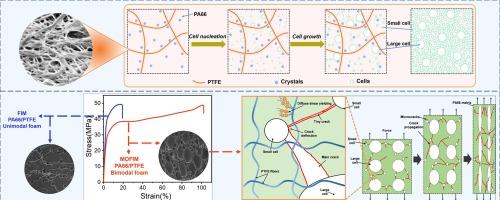Tough and defect-free-surfaces PA66/PTFE composite foam with bimodal structure achieved by high-pressure foam injection molding with mold-opening
IF 5.8
2区 化学
Q1 POLYMER SCIENCE
引用次数: 0
Abstract
Polyamide (PA) 66/polytetrafluoroethylene (PTFE) composite foams with bimodal cellular structures were prepared in this work via mold opening foam injection molding (MOFIM) process. PTFE nanofibrils were in-situ fibrillated within the PA66 matrix during the twin-screw extrusion process, and the PTFE fibrous network significantly enhanced the viscoelastic properties and melt strength of PA66, thus improving the foaming characteristics of the composite material. When the content of PTFE was 5 wt%, the PA66/PTFE composite foam showed a distinct bimodal cellular structure owing to the aggregation of saturated nitrogen (N2) caused by the PTFE network-induced crystallization. The bimodal cells, the PTFE network, and the refined crystalline structure contributed to a significant enhancement in the ductility and mechanical properties of the bimodal PA66/PTFE composite foam, which achieved an improvement in toughness of up to 402.2 %. Moreover, the MOFIM PA66/PTFE composite foam demonstrated superior surface quality due to the two-step foaming in the MOFIM process and the enhanced melt strength by the PTFE network. This work provides new insights into the fabrication of lightweight injection-molded PA composite parts with high performance and surface quality.

通过开模高压泡沫注射成型实现具有双模结构的坚韧无缺陷表面 PA66/PTFE 复合泡沫
本研究通过开模发泡注塑成型(MOFIM)工艺制备了具有双峰蜂窝结构的聚酰胺(PA)66/聚四氟乙烯(PTFE)复合泡沫。在双螺杆挤出过程中,PTFE 纳米纤维在 PA66 基体中原位纤维化,PTFE 纤维网络显著增强了 PA66 的粘弹性能和熔体强度,从而改善了复合材料的发泡特性。当 PTFE 含量为 5 wt% 时,PA66/PTFE 复合泡沫呈现出明显的双峰蜂窝结构,这是由于 PTFE 网络诱导结晶导致饱和氮(N2)聚集所致。双模晶胞、PTFE 网络和细化的结晶结构显著提高了 PA66/PTFE 双模复合泡沫的延展性和机械性能,使其韧性提高了 402.2%。此外,由于 MOFIM 工艺中的两步发泡以及聚四氟乙烯网络增强的熔体强度,MOFIM PA66/PTFE 复合泡沫的表面质量更佳。这项研究为制造具有高性能和表面质量的轻质注塑 PA 复合材料部件提供了新的思路。
本文章由计算机程序翻译,如有差异,请以英文原文为准。
求助全文
约1分钟内获得全文
求助全文
来源期刊

European Polymer Journal
化学-高分子科学
CiteScore
9.90
自引率
10.00%
发文量
691
审稿时长
23 days
期刊介绍:
European Polymer Journal is dedicated to publishing work on fundamental and applied polymer chemistry and macromolecular materials. The journal covers all aspects of polymer synthesis, including polymerization mechanisms and chemical functional transformations, with a focus on novel polymers and the relationships between molecular structure and polymer properties. In addition, we welcome submissions on bio-based or renewable polymers, stimuli-responsive systems and polymer bio-hybrids. European Polymer Journal also publishes research on the biomedical application of polymers, including drug delivery and regenerative medicine. The main scope is covered but not limited to the following core research areas:
Polymer synthesis and functionalization
• Novel synthetic routes for polymerization, functional modification, controlled/living polymerization and precision polymers.
Stimuli-responsive polymers
• Including shape memory and self-healing polymers.
Supramolecular polymers and self-assembly
• Molecular recognition and higher order polymer structures.
Renewable and sustainable polymers
• Bio-based, biodegradable and anti-microbial polymers and polymeric bio-nanocomposites.
Polymers at interfaces and surfaces
• Chemistry and engineering of surfaces with biological relevance, including patterning, antifouling polymers and polymers for membrane applications.
Biomedical applications and nanomedicine
• Polymers for regenerative medicine, drug delivery molecular release and gene therapy
The scope of European Polymer Journal no longer includes Polymer Physics.
 求助内容:
求助内容: 应助结果提醒方式:
应助结果提醒方式:


